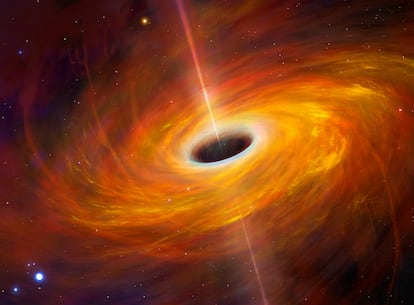Black holes are killing our universe
All galaxies, and the Milky Way is no exception, are dying: They no longer form stars as before, and will end up completely extinguished

The universe, as we know it from our limited and biased vision, is dying. The “whole” is expanding, with the distances between galaxies increasing at an accelerating pace, and, as if that weren’t enough, galaxies are no longer forming as many stars as before. But why has this rate of star formation slowed down? It’s not due to a lack of fuel for creating new galaxies; only about 10% of the gas present in the cosmos has been converted into stars. The mass in the form of planets is even less, a thousand times smaller, indicating that there is ample material available to form new worlds. Yet something is inhibiting the gas — both between galaxies and within them — from generating new suns and planets (and potentially more life?) at the rate it once did.
The most likely culprit behind this phenomenon that is killing our universe is the action of supermassive black holes, which are believed to reside at the centers of all galaxies. This theory is not immediately intuitive, as these cosmic giants — despite having millions or even billions of times the mass of our Sun — are relatively small in size compared to a galaxy.
For instance, the supermassive black hole at the center of the Milky Way is smaller than the orbit of Venus. If these supermassive black holes are indeed responsible for the widespread galacticide in the universe, we are talking about something quite small on a galactic scale, and even more so on a cosmic scale, exerting influence over areas billions of times larger — namely, the galaxies themselves — thus altering the fabric of the entire universe. It’s as if an atom could stop a person from growing, the size ratio is similar, and end an entire species and, by extension all life.
There is evidence, gathered over decades, that the energy that can be produced around supermassive black holes is immense. A black hole exerts such a profound influence on space-time that it twists everything around it, causing even time to warp and potentially come to a standstill. It is often stated that not even light can escape its gravitational pull, although this perspective is somewhat outdated and has been superseded by the principles of general relativity. Nevertheless, it effectively illustrates the idea that even something as formidable as a photon cannot escape the space-time well created by a black hole.
When an object, whether a cloud of interstellar gas or a star, passes near a black hole — yet remains far enough away to avoid being consumed — it forms a disk around the dark entity. As this matter spirals inwards, it experiences immense tidal forces, often described with the analogy that a person would be stretched into a spaghetti-like strand if they ventured too close to a black hole. During this process, the material is heated to such extreme temperatures that it can emit light with a luminosity that matches or even surpasses that of the entire galaxy hosting the supermassive black hole. Despite the galaxy potentially containing billions of times more mass, the radiant energy from the disk can overshadow the galaxy itself.
In instances where the material surrounding a black hole — known as an accretion disk — becomes super bright, the galaxy is classified as having an active galactic nucleus (AGN). In the case of quasars — the most extreme type of AGN — we only see that disk of material around the black hole: its brightness completely eclipses that of the host galaxy.
AGNi can also exhibit a phenomenon that releases vast amounts of energy, not only in the form of light but also by expelling material at speeds close to the speed of light. This ejected material originates not from “inside” the black hole, which is unable to release anything, but rather from just beyond the “point of no return,” known as the event horizon. The ejected material manifests as jets, which can extend to distances equivalent to tens or even hundreds of times the size of a galaxy like the Milky Way.
One example is Porphyrion, whose discovery came to light only a few weeks ago. The ejection of material can also occur because the vicinity of the black hole is so extraordinarily bright that the emitted light itself exerts pressure on the surrounding gas. The fact that light can push objects — much like wind fills a sail — is truly extraordinary!
Although AGNi certainly release vast amounts of energy and have been shown to expel significant quantities of very hot gas from the vicinity of the black hole at supergalactic distances, there is currently no direct evidence to suggest that they can influence the gas throughout an entire galaxy, let alone the cold gas necessary for star formation, which fills the space between stars within a galaxy and is situated far from the supermassive black hole.
Astrophysicists know what to examine to help validate this theory, but conducting such experiments is not so easy. You must identify suitable galaxies where galactic decline is either imminent or has recently occurred. Like detectives, we must gather information on the health status of numerous galaxies and select the most promising candidates for further data collection.
However, choosing the right galaxy for study is not enough; a powerful telescope, such as the James Webb Space Telescope (JWST), is also essential. The search for more direct evidence that supermassive black holes are contributing to the decline of our universe is one of the scientific objectives of the JWST, developed collaboratively by NASA, ESA, and the CSA (the American, European, and Canadian space agencies).
Spain has been actively involved in the James Webb mission through researchers from the Astrobiology Center (CAB), which is part of the National Institute for Aerospace Technology (INTA) and the Spanish National Research Council (CSIC). A team from CAB, in direct collaboration with the University of Cambridge, has recently published an article reporting the first detection of cold gas being expelled from a dying galaxy in the young universe. This galaxy, dubbed “Pablo’s Galaxy,” was the subject of a Nature press release. I presented and defended the findings for an international team that gathered data with JWST to select it, and then some funny colleague named it (behind my back, I must say).
The galaxy, which for the sake of modesty we will refer to as GS10578, is surprisingly massive — comparable in size to the Milky Way — and formed rapidly in the young universe when it was only 15% of its current age. In GS10578, we have found direct evidence of the galacto-homicidal effects of supermassive black holes. The black hole within this galaxy is still active, and we have measured how it is expelling significant quantities of cold gas. Although we cannot directly observe this gas, we detect its presence because it “clouds” the galaxy, lying in the same line of sight and absorbing some of the photons emitted by the stars of GS10578.
We will continue to search for more evidence of the process through which AGNi siphon material from their host galaxies, leading them to starve — much like the fate of the dying GS10578, and ultimately, all galaxies, including our Milky Way, which are all destined to fade away. The universe will be left devoid of shining stars, transforming into something that may seem hostile to us. This future scenario may not feel as much like our universe anymore, highlighting just how insignificant and limited our existence truly is. It serves as a reminder of the smallness of not only our lives but also the material that composes the Earth, the Sun, and all the other planets and stars that exist in the cosmos.
Sign up for our weekly newsletter to get more English-language news coverage from EL PAÍS USA Edition
Tu suscripción se está usando en otro dispositivo
¿Quieres añadir otro usuario a tu suscripción?
Si continúas leyendo en este dispositivo, no se podrá leer en el otro.
FlechaTu suscripción se está usando en otro dispositivo y solo puedes acceder a EL PAÍS desde un dispositivo a la vez.
Si quieres compartir tu cuenta, cambia tu suscripción a la modalidad Premium, así podrás añadir otro usuario. Cada uno accederá con su propia cuenta de email, lo que os permitirá personalizar vuestra experiencia en EL PAÍS.
¿Tienes una suscripción de empresa? Accede aquí para contratar más cuentas.
En el caso de no saber quién está usando tu cuenta, te recomendamos cambiar tu contraseña aquí.
Si decides continuar compartiendo tu cuenta, este mensaje se mostrará en tu dispositivo y en el de la otra persona que está usando tu cuenta de forma indefinida, afectando a tu experiencia de lectura. Puedes consultar aquí los términos y condiciones de la suscripción digital.











































